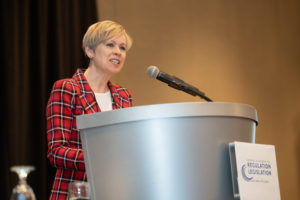Regulatory trends and regulators’ responses
During the first session of the 2019 ASWB Education Conference, attorneys Dale Atkinson and Julie Maciura prepared attendees for later sessions on ways to effect change and make improvements in legislation and regulation.
Each offered a wide-angle look at regulation, bringing a historical and multiprofession perspective to an audience of social work regulators whose daily concerns may be more tightly focused on their own licensees, their jurisdiction’s statutes, and the professions their regulatory bodies regulate.
The two speakers shared the history of professional regulation in the United States and Canada, presenting ideas about why regulation exists; why it should be performed by state and provincial governments; the trends that have brought about the current regulatory climate and will continue to affect regulators; and some predictions for the future. Their perspective spanned centuries and touched on professions and occupations beyond social work. They sought to help attendees embrace the big picture and formulate ways to think about and respond to changes and challenges in regulation.

Atkinson and Maciura offered time lines of professional regulation’s history in their countries. Atkinson pointed to the U.S. Supreme Court case of Dent v State of West Virginia (1889) as pivotal, because it upheld physician licensing and recognized the state’s right to use regulation to protect public health and safety. Regulation of social workers in the United States began in 1934, when Puerto Rico enacted legislation; today, all U.S. jurisdictions regulate social work practitioners. Maciura said that in Canada, voluntary provincial associations were the first to set standards for social work. British Columbia was the first Canadian jurisdiction to establish statutory regulation of social work, in 1969. Today, nearly all Canadian jurisdictions have laws requiring social workers to be registered to practice.
Regulatory trends in the United States and Canada overlap in some areas. One trend is governance reform. Maciura said of regulatory practice in Canada: “The push to reform was concern that the current governance model has increasingly been criticized as putting professional interests ahead of the public interest.” In Ontario, the College of Nurses is undertaking major changes, she said, including decreasing the size of its governing council and increasing the proportion of public members, thereby demonstrating more expertise, efficiency, and impartiality. The college’s proposals, Maciura noted, “have really caused other professions to look at their own governance practices as well, because the feeling is that ‘the writing is on the wall’ and that government is going to be prepared to make changes.”

Atkinson discussed a similar tension between public and professional interests in the United States. The Supreme Court ruling in the North Carolina State Board of Dental Examiners v FTC (2015) means that state boards controlled by licensees must be “actively supervised” by another state entity. To provide for such supervision, some jurisdictions have put in place processes that require any final action by a board to go through the attorney general’s office. In his home state of Illinois, Atkinson said, “All boards are advisory, and nothing is final until it goes up into the bureaucracy for ultimate decision-making.”
This trend toward increasing oversight, Atkinson said, addresses whether regulatory bodies made up of licensees—who bring expertise to their boards—can be trusted to make decisions on behalf of the public. “I think they can,” he said, “but these are the challenges that exist.” The concern about the tension between public protection and professional interest has prompted some U.S. jurisdictions to move to composite boards and boards with a higher proportion of public members.
Another trend seen in Canada and the United States is a move toward more transparency in regulators’ work. Maciura said, “In Ontario, even in the last five years, the amount of information that’s available about regulated professions and practitioners has really exploded.” She said that previously confidential remedial orders and registrants’ criminal charges or bail conditions are now public.
Aside from transparency about practitioners, regulators in Canada are also expected to be more transparent about their processes. A new layer of oversight between government and regulatory bodies is being established, in which fairness commissioners look at entry to practice processes and the registration system to make sure both are transparent, objective, impartial, and fair. In Québec, for example, there is an office ensuring that all 46 professional orders fulfill their function of protecting the public.
“So often the concern is that the regulator doesn't have their eye on the prize. And as Dale has said, ‘The eye on the prize is the protection of the public.’”
Fairness commissioners make sure, she said, “that regulators’ policies and rules about entry to practice are publicly available on the regulator’s website so that applicants can see exactly what it takes to get registered, and exactly how long it will take.” Maciura said, “This is only going to increase. The pressure to be more transparent is seen in a constant stream of newspaper articles about perceived lack of transparency.”
Atkinson affirmed Maciura’s recognition of the call for transparency. He urged regulators to provide legislators with information, even when the regulatory board isn’t allowed by law to lobby. “Invite people into your home, into your house of regulation. Before every board meeting, if I were running your board, I would send a letter to the governor and say, ‘Please come to our meeting; attached is the agenda.’ ” By doing so, Atkinson said, regulators can “get the word out so the perspectives and the knowledge of what it is we do as regulators is more exposed.” This kind of transparency, he added, “can be a very important aspect to setting the stage for the future.”
In closing, Atkinson asserted that, just as a look at history reveals changes in attitudes, the future will inevitably mean more change. He advises regulators to accept and capitalize on this reality. “It’s time that we embrace regulatory evolution and that we do not sit on the status quo,” he said. “The status quo will change, and it has to change. And the idea here is, are we as regulators able to help influence that change in a manner that ensures that the consumers are ultimately protected?”

